 |
The Bead Site =Home>Ancient Beads>India > Etched and dZi Beads
Etched Beads and dZi Beads
The "etching" of beads is a misnomer, because alkalis, not acid is involved in their decoration. They are distinctive and much has been written about them. The two most important works are Etched Carnelian Beads by Horace Beck (1933)
and Etched Beads in Indiaby M.G. Dikshit (1949).
|
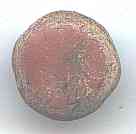
|
Beck divided these beads into three periods. His Early Period (before 2000 BC) corresponds to the Harappan or Indus Valley Civilization, now dated to ca. 2600-1700 BC. This tabular etched bead was obtained in Egypt. Stylistically, it matches these old beads, but there is no way of knowing how old it is.
|
|
His Middle Period (300 BC to AD 200) corresponds to what Indians call the Early Historic Period, now put at something more like 500 BC to AD 500. These are typical designs from that period.
|
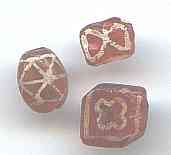
|
|

|
His Late Period (500 to 1000 AD) is now understood to have been mostly the work of Persians, rather than Indians. The Indian industry survived, but few etched beads are found in India, being found in modern Iran and westward, traded into the Middle East and Russia.
The design on the bead on the bottom is a well-known motif of the Persian Sasanian (2nd to 7th century AD) dynasty.
|
|
Beck also recorded two types of etched beads. Type One has white lines on the red stone, as do the beads above. Type Two has black lines on a white bead as at left.
|

|
|

|
In some cases the original stone may have been white, as with this bead. The broken end shows that the stone was white (whether the bead above was or not, is hard to say).
|
|
However, in most cases, Type Two beads are made from carnelians that have first been whitened all over and then had the black lines added. The broken side of this Persian bead shows that clearly.
|
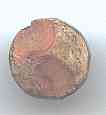
|
|

|
Dikshit also designed a Type Three, which has black lines drawn directly on the red carnelian. These are extremely rare. He also noted two varieties of black on top of white figures and the two colors side by side. These are also very rare.
|
|
What should be regarded as a variety has white lines on a darkened bead. These are usually considered to be "black agate," but all that I could examine are artificially darkened gray chalcedony (like this one) or carnelian.
|

|
|

|
There are also varieties not considered in these schemes. The Harappan Civilization experimented with different combinations. This is a small gray jasper bead that has been etched. Probably Persian.
|
|
The last known Indian to etch carnelians was Saheb Dino of Sehwan (now in Pakistan). He was interviewed in 1930 by Ernest Mackay (1933) and said that he had not done the work for 55 years. He did not make beads, but plaques with passages from the Qor'an.
Here we learned how the process was done. The bead or plaque was fixed in a clay mold tempered with cotton. When it was dried some soda (potassium can also be used) mixed with the juice of the Kirar plant (related to capers) was painted on the stone. (The plant juice had no chemical effect; it only made the mixture opaque so that it could be seen.) The stone was then put into the embers of a charcoal fire for five minutes, then removed and cleaned.
Beck (1933:384-385; 1934:193) determined that the alkali penetrated the surface of the bead/plaque and spread out just under it. The indelible white line is usually quite smooth to the touch. The black lines seem most likely to have been done with copper (Beck 1933: 385).
|

|
Persians continued to make etched beads in the Early Islamic Period. There are a number at Nishapur, Iran (founded by the Sasanians and destroyed in 1221). Later they switched to plaques with Qor'anic verses. They were still being made in the 1930s. A knowledgeable dealer in the late 1970s told me the work had stopped about 50 years before.
|
|
Plaques that resemble them now are actually etched. The designs are cut into the stone with acid and filled in with white paint or something similar.
|
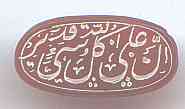
|
|
Oh, all right. But we want to know about dZi beads!
Dzi ("zee") beads are very popular and much energy has been spent upon them. Yet, no one knows where and when they were made. Some people claim to know, but I have yet to see a convincing argument.
But we can examine how they were made. Two processes are usually involved. One is the staining of a stone brown or black as is done for onyx. The second is the so-called "etching." When darkening the stone, areas are blocked off with a resist (such as grease). Later these areas are whitened by the "etching" process.
|
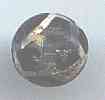
|
Another side of the blackened etched bead shown above. In the center are lines that were blocked from being darkened (they show up as gray) and were accidentally not "etched" with white.
I know of three beads excavated in the Indian subcontinent dating between ca. 2000 and 1000 BC that have lines left gray or whitish when the rest of the bead was darkened. Blackened beads with white lines show up in the Early Historic Period.
|
|
A genuine dZi bead (to the best of my knowledge). The original stone was a light brown. The ends and the areas of the white lines were prevented from absorbing the sugar that made the three dark stripes in the center black. After this process, the white lines were added.
|
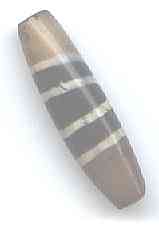
|
|

|
A natural dZi bead? Could be. The black and brown combination is unusual, though not impossible. The thin white lines appear to be natural.
|
|
Imitations of these expensive beads abound. One of the better older ones is made of plastic, filled with metal to give it weight. Probably European.
|
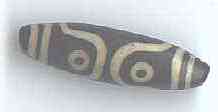
|
|
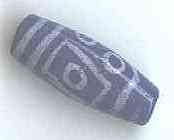
|
An Indian glass imitation. The blue color is a dead give-away. The white was added by putting powdered white glass in a mold and rolling the hot blue base over it, picking up the white. It is known as "powder-glass decoration."
|
|
A really bad imitation. Apparently blackened bone. The lines were cut into the body and then filled with white paint or some such substance.
There are much better stone imitations on the market these days. Buyers beware. I don't have an example. Perhaps someone will donate one.
|
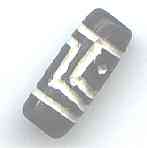
|
|

|
Ever see a dZi pendant? And a natural one at that?
|
|
References:
Beck, Horace C. 1933 Etched Carnelian Beads. The Antiquaries Journal XIII: 384-397.
------1934 The Use of the Microscope in the Study of Ancient Beads. Journal of the Royal Microscopic Society LIV: 186-194.
Dikshit, M. G. 1949 Etched Beads in India Deccan College Monograph Series 4. Poona: Deccan College Postgraduate and Research Institute.
Mackay, Ernest 1933 Decorated Carnelian Beads Man 33:143-146.
__________________________________________________
Small Bead Businesses | Beading & Beadwork | Ancient Beads | Trade Beads
Beadmaking & Materials | Bead Uses | Researching Beads | Beads and People
Center for Bead Research | Book Store | Free Store | Bead Bazaar
Shopping Mall | The Bead Auction | Galleries | People | Events
The Bead Site Home | Chat Line | Contact Us | Site Search Engine | FAQ
|
 |


















